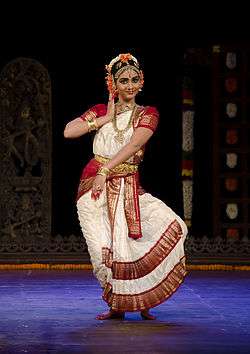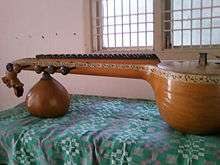Culture of Andhra Pradesh
| Part of a series on the |
| Culture of Andhra Pradesh |
|---|
 |
| History |
| People and culture |
|
The culture of Andhra Pradesh state in India has many aspects.
Religion and philosophy
Andhra Pradesh is home to Hindu saints of all castes. An important figure is Saint Yogi Potuluri Veerabrahmam, who was a Viswa Brahmin that even had Brahmin, Sudhra Harijan and Muslim disciples.[1] Fisherman Raghu was also a Sudhra.[2]
Several important Hindu modern-day saints are from Andhra Pradesh. These include Nimbarka who founded Dvaitadvaita, Mother Meera who advocated Indian independence and Aurobindo Mission, Sri Sathya Sai Baba and Swami Sundara Chaitanyanandaji.
Pilgrimage places

- Tirupati or Tirumala, where the main temple is dedicated to the Hindu god Venkateswara.
- Simhachalam is said in mythology to be the abode of the saviour-god Narasimha, who rescued Prahlada from abusive father Hiranyakasipu.
- Srisailam is dedicated mainly to Shiva. It is one of the locations of the various Jyotirlingams. In Andhra Pradesh Tirupati is there
Festivals
- Makara Sankranti in January. Makara means crocodile.
- Maha Shivaratri in February/March.
- Ugadi or the Telugu New Year in March/April.
- Sri Rama Navami celebrated in March/April 9 days after Ugadi.
- Varalakshmi Vratam in August.
- Vinayaka Chaviti in August.
- Dasara in September/October.
- Atla Tadde 3rd day in bright half of Aswiyuja month (falls in September/October in Gregorian calendar)
- Deepavali in October/November.
- Deepothsavam during the Deepavali season.
Vadi Biyyam
Vadi Biyyam is a traditional ceremony performed for married couples in Rayalaseema, Telangana and parts of Andhra Regions. The ceremony starts before the marriage. After marriage, the ceremony is performed at least once in three years, wherein the parents of the married woman invite all the relatives for the ceremony celebration.[3]
The Process
Parents of the married woman give money to buy clothes for the ceremony. A good quantity of rice is mixed with turmeric, dried coconut core and other ingredients. Five married women (not widowed) come one after and another and put rice in a cloth wrapped around the neck and spread out in the front.
Cultural institutions
Andhra Pradesh has many museums, including the Archaeological Museum at Amaravati near Guntur City that features relics of nearby ancient sites, the Salar Jung Museum in Hyderabad, which features a varied collection of sculptures, paintings, and religious artifacts, the Visakha Museum in Visakhapatnam, which displays the history of the pre-Independence Madras Presidency in a rehabilitated Dutch bungalow and Victoria Jubilee Museum in Vijayawada, which has a collection of ancient sculptures, paintings, idols, weapons, cutlery, and inscriptions.
Other cultural elements

Bapu's paintings, Nanduri Subbarao's Yenki Paatalu (Songs on/by a washerwoman called Yenki), mischievous Budugu (a character by Mullapudi), Annamayya's songs, Aavakaaya (a variant of mango pickle in which the kernel of mango is retained), Gongura (a chutney from Roselle plant), Atla Taddi (a seasonal festival predominantly for teenage girls), banks of river Godavari, Dudu basavanna (The ceremonial ox decorated for door-to-door exhibition during the harvest festival Sankranti) have long defined Telugu culture. The village of Durgi is known for originating stone craft, carvings of idols in soft stone that must be exhibited in the shade because they are prone to weathering.
Architecture
There are two distinct architectural traditions in Andhra Pradesh. The first traces back to the building of the city of Amaravathi under Satavahanas. This unique style of architecture emphasises the use of intricate and abstract sculpture with inspiration from religious themes. The second tradition draws on the enormous granite and lime stone reserves of the region and is reflected in the various temples and forts built over a very long period of time.
Literature
As an ancient language, Telugu has a rich and deep literary culture. Nannaya, Tikkana, Yerrapragada, Srinatha, Molla (poet), and Tarikonda Venkamamba made Telugu language "The Italian of the East" - lingua franca for religious, musical composition and philosophy. The contributions of Charles Phillip Brown, Vemana, Sri Sri (writer) and Viswanatha Satyanarayana made Telugu a vibrant and evolving modern language. The contributions of various Telugu/Tamil/Sanskrit grammarians to the formalisation of English Grammar gave Telugu Literary traditions a truly global reach.
Telugu literature is highly influenced by Sanskrit literature and Hindu scriptures. Nannayya, Tikkana, and Yerrapragada form the trinity who translated the great epic Mahabharatha into Telugu. Bammera Potana is another great poet from vontimitta (kadapa dist) famous for his great classic Sri Madandhra Maha Bhagavatamu, a Telugu translation of 'Sri Bhagavatam' authored by Veda Vyasa in Sanskrit. Nannayya derived the present Telugu script (lipi) from the old Telugu-Kannada script. Emperor Krishna Deva Raya wrote and also made the famous statement : "Desha Bhashalandu Telugu lessa" meaning "Telugu is the sweetest amongst all Indian languages". Famous Tamil poet Mahakavi bharathiyar wrote "sundhara telungunil paatisaithu" which literally means create songs in beautiful telugu.Philosophical poems by Yogi-Vemana are quite famous. Modern writers include Jnanpith Award winners Sri Viswanatha Satya Narayana and Dr. C. Narayana Reddy. Revolutionary poets like SriSri and Gaddar are popular.
Cuisine
Andhra Pradesh cuisine includes Bandhar Laddu, Avakaya, Gongura, Pulusu, pappu charu, jonna kudu, bobbattu, kaza, and arisa. It uses spices, fruit and vegetable harvests of the region.
Rice is the staple food and is used in a wide variety of ways. Typically, rice is either boiled and eaten with curry, or made into a batter for use in a crepe-like dish called attu (pesarattu) or dosas.The rice which is eaten is usually eaten with papi , a simple curry .
Meat, vegetables, and greens are prepared with different masalas into a variety of strongly flavored dishes.The Indian Cuisine has its unique style and tradition.
Performing arts
Annamayya, Tyagaraja, Kuchipudi summarise the rich artistic traditions of Andhra Pradesh. Contributions of Annamacharya and Tyagaraja to the "grammar of sound" made Telugu language the preferred language of composition for Carnatic Music and made Andhra Pradesh the mother of all modern music. Their influence not only on Carnatic but global classical music and the organisation of sound as a medium of emotional resonance has no parallel in human history. Kuchipudi as a refinement of the ancient art of Bharathanatyam, and in the context of the unique religious and cultural traditions of Andhra Pradesh stands on par with all the great global traditions of Classical Dance.
Dance

Jayapa Senani (Jayapa Nayudu) is the first person who wrote about the dances prevalent in Andhra Pradesh.[4] Both Desi and Margi forms of dances have been included in his Sanskrit treatise 'Nritya Ratnavali'. It contains eight chapters. Folk dance forms like Perani, Prenkhana, Suddha Nartana, Carcari, Rasaka, Danda Rasaka, Shiva Priya, Kanduka Nartana, Bhandika Nrityam, Carana Nrityam, Chindu, Gondali and Kolatam are described. In the first chapter the author deals with discussion of the differences between Marga and Desi, Tandava and lasya, Natya and Nritta. In the 2nd and 3rd chapters he deals with Angi-kabhinaya, Caris, Sthanakas and Mandalas. In the 4th Chapter Karnas, angaharas and recakas are described. In following chapters he described the local dance forms i.e. Desi Nritya. In the last chapter he deals with art and practice of dance.
Classical dance in Andhra can be performed by both men and women; however women tend to learn it more often. Kuchipudi is the state's best-known classical dance forms of Andhra Pradesh. The various dance forms that existed through the states’ history are Chenchu Bhagotam, Kuchipudi, Bhamakalapam, Burrakatha, Veeranatyam, Butta bommalu, Dappu, Tappeta Gullu, Dhimsa, and Kolattam.
Music

The state has a rich musical heritage. Many legends of the Carnatic music including two among Trinity of Carnatic music (Thyagaraja and Syama Sastri) were of Telugu descent. Other composers include Annamacharya, Kshetrayya, and Bhadrachala Ramadasu.
Folk songs are also popular in the rural areas of the state.
Movies
Costume
Andhra Pradesh is home to some of the finest historical cloth making/fashion and dying traditions of the world. Its rich cotton production, with its innovative plant dye extraction history stand next to its diamond mining, pearl harvesting and jewelry traditions to form an impressive fashion tradition that has stood the test of time. The ancient Golconda mine is the mother of the numerous legendary gems such as the Koh-i-Noor and Hope Diamond. Andhra Pradesh had a virtual monopoly in the global jewelry industry till 1826 (founding of the diamond mines in Rhodesia- Africa) and eight of the 10 most valuable jewelry pieces on earth today trace their history back to Andhra Pradesh. Langa-Voni (Half saree), Sarees made in Kalamkari, Bidri, Nirmal paintings, fascinating weaves from Pochampalli, Gadwal, Venkatagiri are the result of this time tested (3000 year) fashion tradition. Vaddaanam, Aravanke, Kashulahaaram, Buttalu and various standard gold jewelry designs are fine examples of this continuously evolving ancient tradition.
References
- ↑ "Archived copy". Archived from the original on 2008-11-20. Retrieved 2008-11-29.
- ↑ "Stories of Bhaktas - Fisherman Raghu - www.telugubhakti.com".
- ↑ http://www.kiranreddys.com/telugu/culture.php
- ↑ Ntitya Ratnavali http://www.telugupeople.com/discussion/article.asp?id=111